Module 9 Unit 1 The world's population was about 7.8 billion in 2020.课件(共22张PPT) 外研版英语八年级上册
文档属性
| 名称 | Module 9 Unit 1 The world's population was about 7.8 billion in 2020.课件(共22张PPT) 外研版英语八年级上册 | 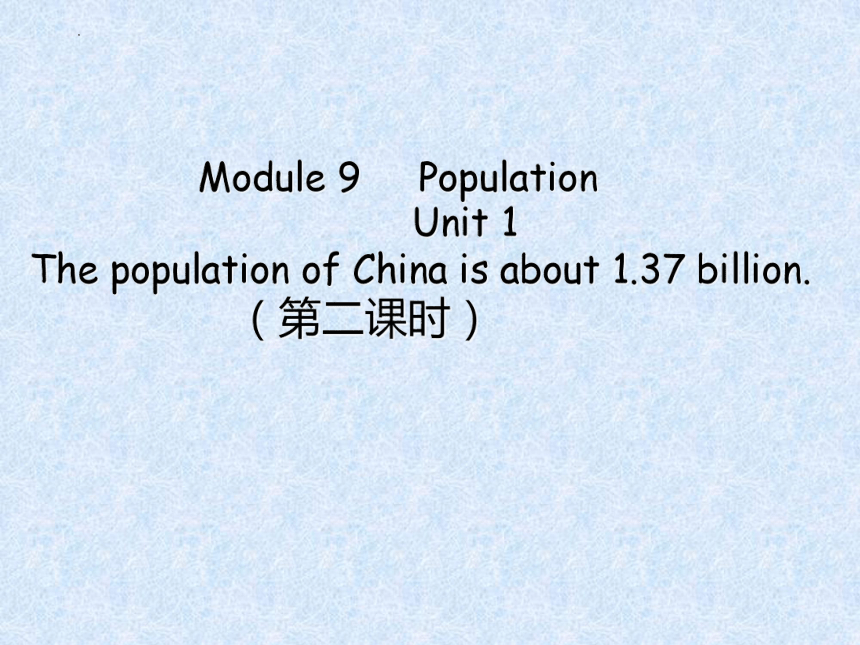 | |
| 格式 | pptx | ||
| 文件大小 | 182.9KB | ||
| 资源类型 | 教案 | ||
| 版本资源 | 外研版 | ||
| 科目 | 英语 | ||
| 更新时间 | 2024-12-12 20:49:07 | ||
图片预览

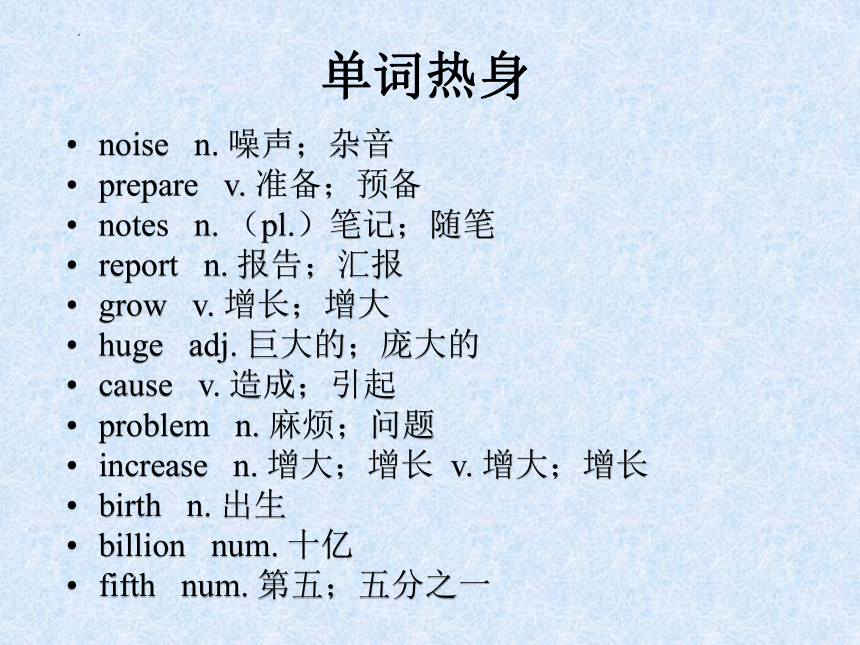
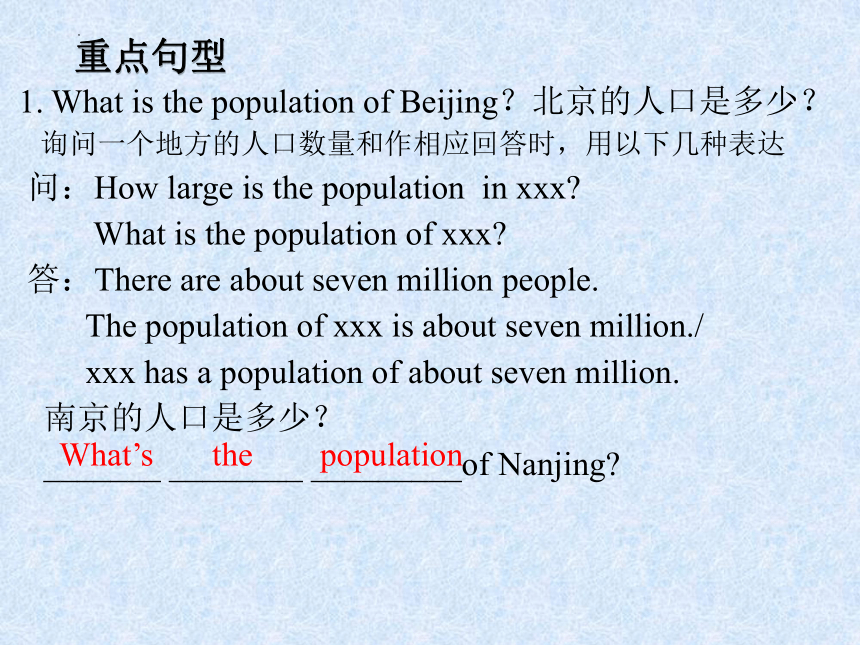
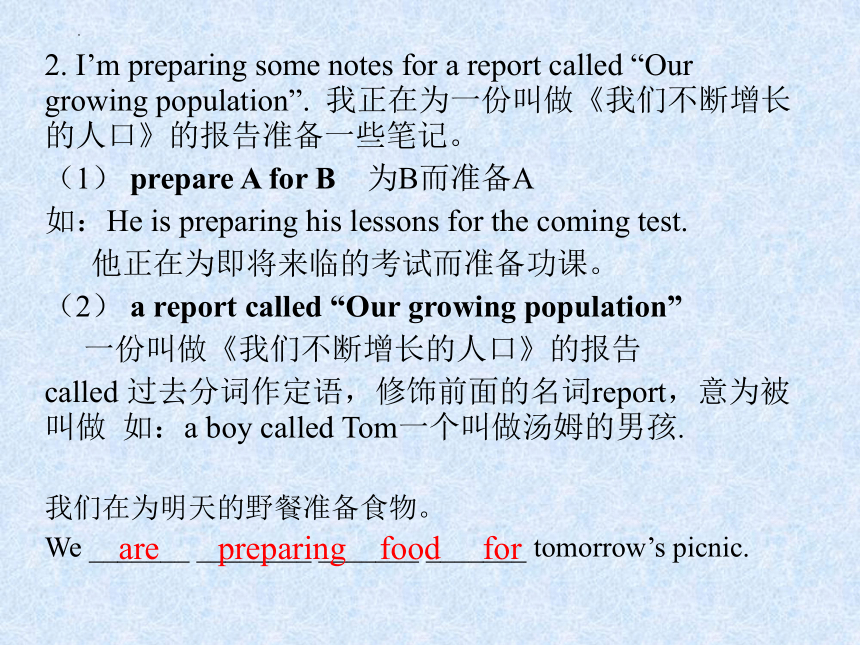
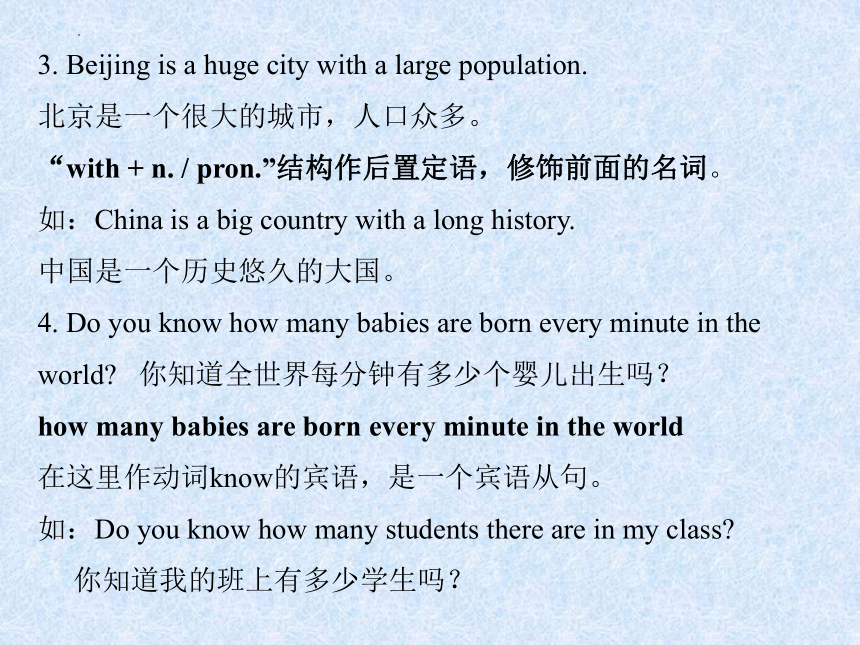
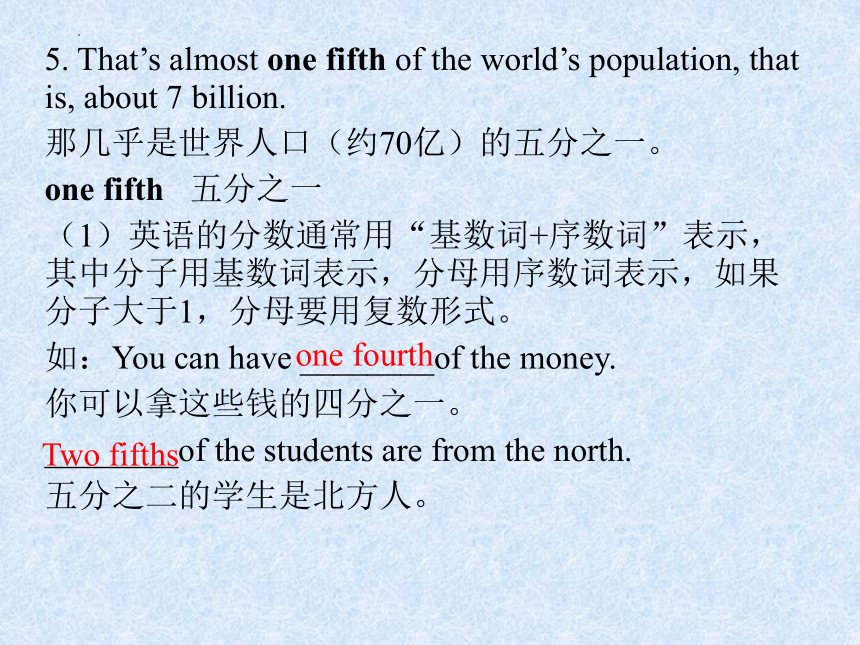
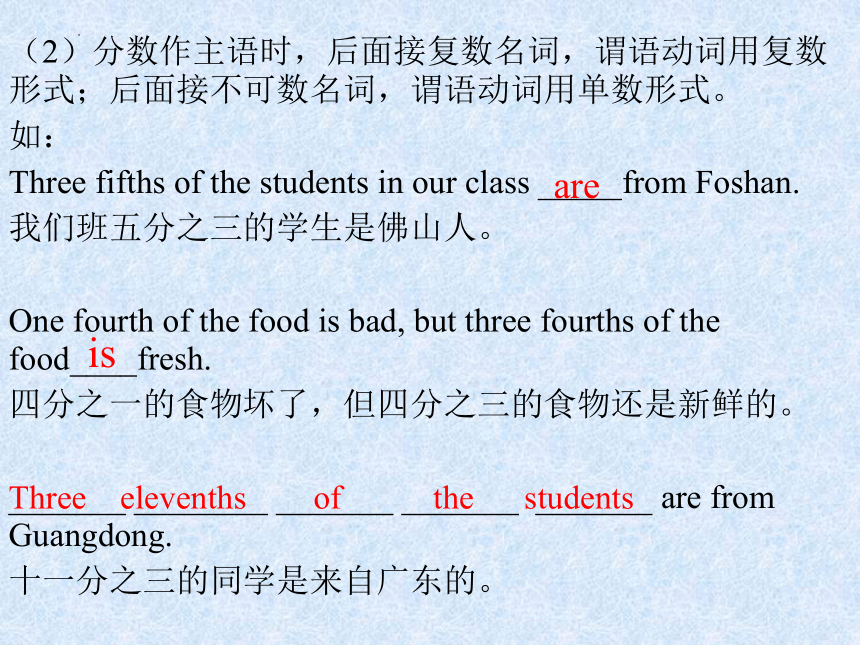
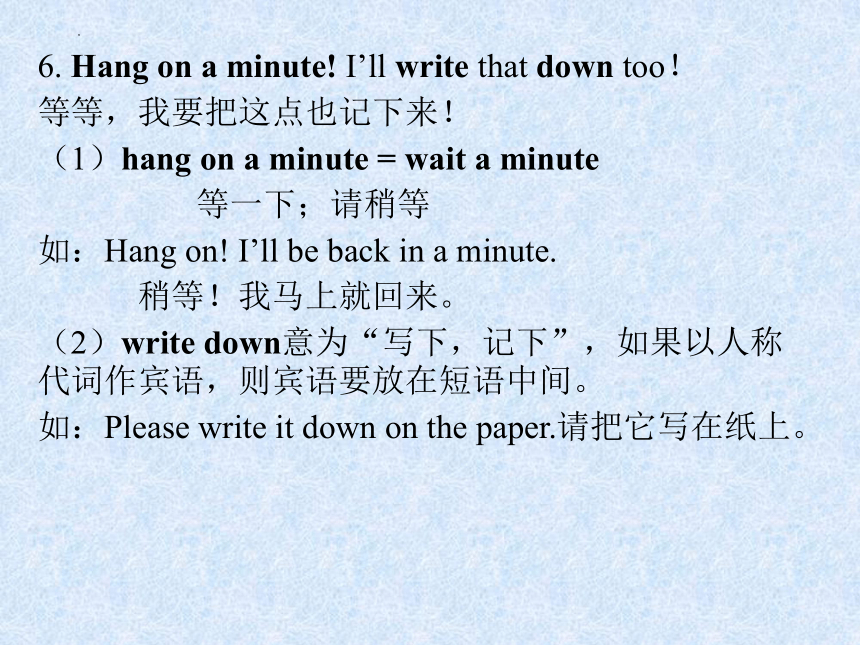
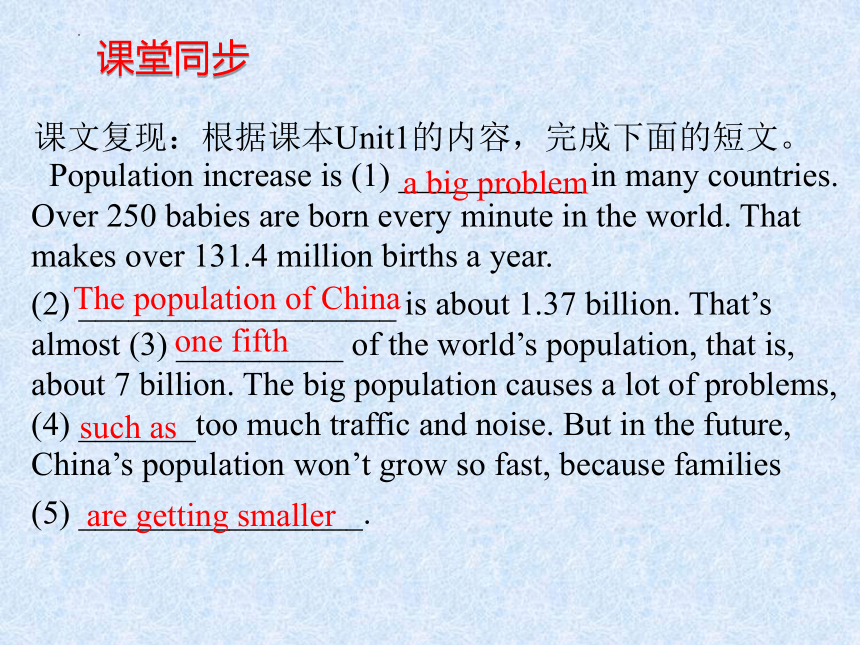
文档简介
(共22张PPT)
Module 9 Population
Unit 1
The population of China is about 1.37 billion.
(第二课时)
单词热身
noise n. 噪声;杂音
prepare v. 准备;预备
notes n. (pl.)笔记;随笔
report n. 报告;汇报
grow v. 增长;增大
huge adj. 巨大的;庞大的
cause v. 造成;引起
problem n. 麻烦;问题
increase n. 增大;增长 v. 增大;增长
birth n. 出生
billion num. 十亿
fifth num. 第五;五分之一
What is the population of Beijing?北京的人口是多少?
询问一个地方的人口数量和作相应回答时,用以下几种表达
问:How large is the population in xxx
What is the population of xxx
答:There are about seven million people.
The population of xxx is about seven million./
xxx has a population of about seven million.
南京的人口是多少?
_______ ________ _________of Nanjing
重点句型
What’s the population
2. I’m preparing some notes for a report called “Our growing population”. 我正在为一份叫做《我们不断增长的人口》的报告准备一些笔记。
(1) prepare A for B 为B而准备A
如:He is preparing his lessons for the coming test.
他正在为即将来临的考试而准备功课。
(2) a report called “Our growing population”
一份叫做《我们不断增长的人口》的报告
called 过去分词作定语,修饰前面的名词report,意为被叫做 如:a boy called Tom一个叫做汤姆的男孩.
我们在为明天的野餐准备食物。
We _______ ________ _______ _______ tomorrow’s picnic.
are preparing food for
3. Beijing is a huge city with a large population.
北京是一个很大的城市,人口众多。
“with + n. / pron.”结构作后置定语,修饰前面的名词。
如:China is a big country with a long history.
中国是一个历史悠久的大国。
4. Do you know how many babies are born every minute in the world 你知道全世界每分钟有多少个婴儿出生吗?
how many babies are born every minute in the world
在这里作动词know的宾语,是一个宾语从句。
如:Do you know how many students there are in my class
你知道我的班上有多少学生吗?
5. That’s almost one fifth of the world’s population, that is, about 7 billion.
那几乎是世界人口(约70亿)的五分之一。
one fifth 五分之一
(1)英语的分数通常用“基数词+序数词”表示,其中分子用基数词表示,分母用序数词表示,如果分子大于1,分母要用复数形式。
如:You can have ________of the money.
你可以拿这些钱的四分之一。
________of the students are from the north.
五分之二的学生是北方人。
one fourth
Two fifths
(2)分数作主语时,后面接复数名词,谓语动词用复数形式;后面接不可数名词,谓语动词用单数形式。
如:
Three fifths of the students in our class _____from Foshan.
我们班五分之三的学生是佛山人。
One fourth of the food is bad, but three fourths of the food____fresh.
四分之一的食物坏了,但四分之三的食物还是新鲜的。
_______ ________ _______ _______ _______ are from Guangdong.
十一分之三的同学是来自广东的。
are
is
Three elevenths of the students
6. Hang on a minute! I’ll write that down too!
等等,我要把这点也记下来!
(1)hang on a minute = wait a minute
等一下;请稍等
如:Hang on! I’ll be back in a minute.
稍等!我马上就回来。
(2)write down意为“写下,记下”,如果以人称代词作宾语,则宾语要放在短语中间。
如:Please write it down on the paper.请把它写在纸上。
课文复现:根据课本Unit1的内容,完成下面的短文。
课堂同步
Population increase is (1) ___________ in many countries. Over 250 babies are born every minute in the world. That makes over 131.4 million births a year.
(2) ___________________ is about 1.37 billion. That’s almost (3) __________ of the world’s population, that is, about 7 billion. The big population causes a lot of problems, (4) _______too much traffic and noise. But in the future, China’s population won’t grow so fast, because families
(5) _________________.
The population of China
a big problem
one fifth
such as
are getting smaller
冠词和数词
一、冠词
1.英语中的冠词有三个,即the,a和an,其中the是定冠词,a和an是不定冠词。
2.冠词the的主要用法
(1) 指出谈话双方都知道的人或事物
Open the door, please.
(2) 重复上文提到的事物
There is a book on my desk. The book is about animals.
(3)表示世界上独一无二的事物
The earth goes round the sun.
语法导学
(4)用在形容词最高级前面
This is the best film I have ever seen.
(5) 用在序数词前面
He is the first student to get to school.
(6) 用在由普通名词构成的专有名词前
I have visited the Palace Museum once.
(7) 用于乐器之前
That little boy can play the piano very well.
(8) 与姓氏的复数形式一起表示一家人或两夫妇
The Greens are having supper right now.
(9)与某些形容词连用,代表某一类人或事物
The rich should help the poor.
(10)常见的含有定冠词的短语:
all the time 一直
at the same time 与此同时
by the way 顺便问一下
in the end 最后
in the middle of 在 …… 的中间
go to the cinema 看电影
the same as 和 …… 一样
in the morning 在上午
in the afternoon 在下午
the more, the better 越多越好
with the help of 在 …… 的帮助下
3.不定冠词a和an的用法
a和an主要泛指某一个人或事物,也可泛指一类人或一类事物,后面接单数可数名词。a用在以辅音音素开头的词前,an用在以元音音素开头的词前,特别注意是以音标而非字母为标准。
如:
a useful [ 'ju sf l ] book(useful是以元音字母开头的词,但其发音是以辅音音素开头的)
an hour ['a ] (hour是以辅音字母开头的词,但其发音是以元音音素开头的)
语法导学
不定冠词a和an的主要用法如下:
(1) 指一类人或事物
A plane is a machine that can fly.
(2) 第一次提及某人或某物,非特指
A boy is waiting for you.
(3) 表示“每一”,相当于every
We study eight hours a day.
语法导学
(4)含有不定冠词的短语:
a few少数;几个
a little少量;一点点
a bit一点点
a lot of许多
have a good time过得开心
take a boat坐船
take a bus坐公共汽车
take a bath洗澡
have a cold患感冒
have a fever发烧
go for a walk去散步
语法导学
4.零冠词(名词前不用冠词)
(1)一日三餐前一般不用冠词。
如:have breakfast, have lunch, have supper, have dinner
(2)体育活动、娱乐、游戏前不用定冠词。
如:play basketball, play golf, play bridge(桥牌)
(3)节假日前不用冠词。
如:New Year’s Day, Children’s Day, Christmas Day
语法导学
(4)国名、城市名、人名、车站名、街道名称、公园、学校名称前不用冠词。
如:China, Beijing, Mark Twain, Guangzhou East Railway Station, Dongfeng Street, Zhongshan Park, peking University, Huaying School
(5)名词前有this, my, whose, some, no, each, every等词时不用冠词。
如:I want this book, not that one.
(6)在星期几、月份、季节前一般不用冠词。
如:on Tuesday, in November, in autumn
语法导学
(7)与by连用的表示交通工具或方式的名词前不用冠词。
如:I go to school by bus every day.
(8)学科、语言名称前不用冠词。
如:I like maths very much.
(9)常见的不用冠词的短语:
on Sunday在周日 in September在九月
in spring在春季 go home回家
on holiday度假 at last最后
by bus / bike / train 坐公共汽车 / 骑自行车 / 坐火车
on earth究竟 from time to time不时地
语法导学
go to school / bed / work上学 / 睡觉 / 上班
day by day一天天地 face to face面对面
go to college / university上大学
in fact事实上 take care of照顾
make friends (with …) (与 …… )交朋友
at home在家 at work在上班
after school放学后 after class课后
in class在课堂上 watch TV看电视
for example例如 in time及时
stay in bed躺在床上 at first首先
at night / noon / midnight在晚上 / 中午 / 半夜
语法导学
注意:有些名词前用或不用冠词,其意义有所不同。
如:at school 上学 at the school 在学校
at table 在吃饭 at the table 在餐桌旁
in bed(躺、睡)在床上
in the bed(某人 / 某物)在床上
in hospital 生病住院 in the hospital 在医院里
go to school 去上学 go to the school 去学校
go to church 去做礼拜 go to the church 到教堂去
in class 在课堂上 in the class 在班级里
in front of 在 …… 的前面(范围外)
in the front of 在 …… 的前部(范围内)
语法导学
用适当的冠词填空,不需要用冠词的地方填“ / ”。
1.There will be ____ English evening party in the garden next Saturday.
2.She has ____ useful book on languages.
3.Here is ____ basket. ____ basket is his.
4.Is Canada ____ English speaking country
5.What ____ interesting film!
6.There is ____ orange tree behind ____ house.
7. ____ woman over there is ____ popular teacher in our school.
8.Does Tom often play ____ basketball after school
9.Shanghai is in ____ east of China.
10.We can’t see ____ sun at ____ night.
语法导学
an
a The
an
an
an the
The
a
/ /
the
a
【即学即练1】
the
/
Homework
Finish the exercises in the Test Paper.
Module 9 Population
Unit 1
The population of China is about 1.37 billion.
(第二课时)
单词热身
noise n. 噪声;杂音
prepare v. 准备;预备
notes n. (pl.)笔记;随笔
report n. 报告;汇报
grow v. 增长;增大
huge adj. 巨大的;庞大的
cause v. 造成;引起
problem n. 麻烦;问题
increase n. 增大;增长 v. 增大;增长
birth n. 出生
billion num. 十亿
fifth num. 第五;五分之一
What is the population of Beijing?北京的人口是多少?
询问一个地方的人口数量和作相应回答时,用以下几种表达
问:How large is the population in xxx
What is the population of xxx
答:There are about seven million people.
The population of xxx is about seven million./
xxx has a population of about seven million.
南京的人口是多少?
_______ ________ _________of Nanjing
重点句型
What’s the population
2. I’m preparing some notes for a report called “Our growing population”. 我正在为一份叫做《我们不断增长的人口》的报告准备一些笔记。
(1) prepare A for B 为B而准备A
如:He is preparing his lessons for the coming test.
他正在为即将来临的考试而准备功课。
(2) a report called “Our growing population”
一份叫做《我们不断增长的人口》的报告
called 过去分词作定语,修饰前面的名词report,意为被叫做 如:a boy called Tom一个叫做汤姆的男孩.
我们在为明天的野餐准备食物。
We _______ ________ _______ _______ tomorrow’s picnic.
are preparing food for
3. Beijing is a huge city with a large population.
北京是一个很大的城市,人口众多。
“with + n. / pron.”结构作后置定语,修饰前面的名词。
如:China is a big country with a long history.
中国是一个历史悠久的大国。
4. Do you know how many babies are born every minute in the world 你知道全世界每分钟有多少个婴儿出生吗?
how many babies are born every minute in the world
在这里作动词know的宾语,是一个宾语从句。
如:Do you know how many students there are in my class
你知道我的班上有多少学生吗?
5. That’s almost one fifth of the world’s population, that is, about 7 billion.
那几乎是世界人口(约70亿)的五分之一。
one fifth 五分之一
(1)英语的分数通常用“基数词+序数词”表示,其中分子用基数词表示,分母用序数词表示,如果分子大于1,分母要用复数形式。
如:You can have ________of the money.
你可以拿这些钱的四分之一。
________of the students are from the north.
五分之二的学生是北方人。
one fourth
Two fifths
(2)分数作主语时,后面接复数名词,谓语动词用复数形式;后面接不可数名词,谓语动词用单数形式。
如:
Three fifths of the students in our class _____from Foshan.
我们班五分之三的学生是佛山人。
One fourth of the food is bad, but three fourths of the food____fresh.
四分之一的食物坏了,但四分之三的食物还是新鲜的。
_______ ________ _______ _______ _______ are from Guangdong.
十一分之三的同学是来自广东的。
are
is
Three elevenths of the students
6. Hang on a minute! I’ll write that down too!
等等,我要把这点也记下来!
(1)hang on a minute = wait a minute
等一下;请稍等
如:Hang on! I’ll be back in a minute.
稍等!我马上就回来。
(2)write down意为“写下,记下”,如果以人称代词作宾语,则宾语要放在短语中间。
如:Please write it down on the paper.请把它写在纸上。
课文复现:根据课本Unit1的内容,完成下面的短文。
课堂同步
Population increase is (1) ___________ in many countries. Over 250 babies are born every minute in the world. That makes over 131.4 million births a year.
(2) ___________________ is about 1.37 billion. That’s almost (3) __________ of the world’s population, that is, about 7 billion. The big population causes a lot of problems, (4) _______too much traffic and noise. But in the future, China’s population won’t grow so fast, because families
(5) _________________.
The population of China
a big problem
one fifth
such as
are getting smaller
冠词和数词
一、冠词
1.英语中的冠词有三个,即the,a和an,其中the是定冠词,a和an是不定冠词。
2.冠词the的主要用法
(1) 指出谈话双方都知道的人或事物
Open the door, please.
(2) 重复上文提到的事物
There is a book on my desk. The book is about animals.
(3)表示世界上独一无二的事物
The earth goes round the sun.
语法导学
(4)用在形容词最高级前面
This is the best film I have ever seen.
(5) 用在序数词前面
He is the first student to get to school.
(6) 用在由普通名词构成的专有名词前
I have visited the Palace Museum once.
(7) 用于乐器之前
That little boy can play the piano very well.
(8) 与姓氏的复数形式一起表示一家人或两夫妇
The Greens are having supper right now.
(9)与某些形容词连用,代表某一类人或事物
The rich should help the poor.
(10)常见的含有定冠词的短语:
all the time 一直
at the same time 与此同时
by the way 顺便问一下
in the end 最后
in the middle of 在 …… 的中间
go to the cinema 看电影
the same as 和 …… 一样
in the morning 在上午
in the afternoon 在下午
the more, the better 越多越好
with the help of 在 …… 的帮助下
3.不定冠词a和an的用法
a和an主要泛指某一个人或事物,也可泛指一类人或一类事物,后面接单数可数名词。a用在以辅音音素开头的词前,an用在以元音音素开头的词前,特别注意是以音标而非字母为标准。
如:
a useful [ 'ju sf l ] book(useful是以元音字母开头的词,但其发音是以辅音音素开头的)
an hour ['a ] (hour是以辅音字母开头的词,但其发音是以元音音素开头的)
语法导学
不定冠词a和an的主要用法如下:
(1) 指一类人或事物
A plane is a machine that can fly.
(2) 第一次提及某人或某物,非特指
A boy is waiting for you.
(3) 表示“每一”,相当于every
We study eight hours a day.
语法导学
(4)含有不定冠词的短语:
a few少数;几个
a little少量;一点点
a bit一点点
a lot of许多
have a good time过得开心
take a boat坐船
take a bus坐公共汽车
take a bath洗澡
have a cold患感冒
have a fever发烧
go for a walk去散步
语法导学
4.零冠词(名词前不用冠词)
(1)一日三餐前一般不用冠词。
如:have breakfast, have lunch, have supper, have dinner
(2)体育活动、娱乐、游戏前不用定冠词。
如:play basketball, play golf, play bridge(桥牌)
(3)节假日前不用冠词。
如:New Year’s Day, Children’s Day, Christmas Day
语法导学
(4)国名、城市名、人名、车站名、街道名称、公园、学校名称前不用冠词。
如:China, Beijing, Mark Twain, Guangzhou East Railway Station, Dongfeng Street, Zhongshan Park, peking University, Huaying School
(5)名词前有this, my, whose, some, no, each, every等词时不用冠词。
如:I want this book, not that one.
(6)在星期几、月份、季节前一般不用冠词。
如:on Tuesday, in November, in autumn
语法导学
(7)与by连用的表示交通工具或方式的名词前不用冠词。
如:I go to school by bus every day.
(8)学科、语言名称前不用冠词。
如:I like maths very much.
(9)常见的不用冠词的短语:
on Sunday在周日 in September在九月
in spring在春季 go home回家
on holiday度假 at last最后
by bus / bike / train 坐公共汽车 / 骑自行车 / 坐火车
on earth究竟 from time to time不时地
语法导学
go to school / bed / work上学 / 睡觉 / 上班
day by day一天天地 face to face面对面
go to college / university上大学
in fact事实上 take care of照顾
make friends (with …) (与 …… )交朋友
at home在家 at work在上班
after school放学后 after class课后
in class在课堂上 watch TV看电视
for example例如 in time及时
stay in bed躺在床上 at first首先
at night / noon / midnight在晚上 / 中午 / 半夜
语法导学
注意:有些名词前用或不用冠词,其意义有所不同。
如:at school 上学 at the school 在学校
at table 在吃饭 at the table 在餐桌旁
in bed(躺、睡)在床上
in the bed(某人 / 某物)在床上
in hospital 生病住院 in the hospital 在医院里
go to school 去上学 go to the school 去学校
go to church 去做礼拜 go to the church 到教堂去
in class 在课堂上 in the class 在班级里
in front of 在 …… 的前面(范围外)
in the front of 在 …… 的前部(范围内)
语法导学
用适当的冠词填空,不需要用冠词的地方填“ / ”。
1.There will be ____ English evening party in the garden next Saturday.
2.She has ____ useful book on languages.
3.Here is ____ basket. ____ basket is his.
4.Is Canada ____ English speaking country
5.What ____ interesting film!
6.There is ____ orange tree behind ____ house.
7. ____ woman over there is ____ popular teacher in our school.
8.Does Tom often play ____ basketball after school
9.Shanghai is in ____ east of China.
10.We can’t see ____ sun at ____ night.
语法导学
an
a The
an
an
an the
The
a
/ /
the
a
【即学即练1】
the
/
Homework
Finish the exercises in the Test Paper.
同课章节目录
- Module 1 How to learn English
- Unit 1 Let's try to speak English as much as possi
- Unit 2 You should smile at her.
- Unit 3 Language in use .
- Module 2 My home town and my country
- Unit 1 It's taller than many other buildings.
- Unit 2 Cambridge is a beautiful city in the east o
- Unit 3 Language in use .
- Module 3 Sports.
- Unit 1 Nothing is more exciting than playing tenni
- Unit 2 This year we training more carefully.
- Unit 3 Language in use .
- Module 4 Planes, ships and trains .
- Unit 1 He lives the farthest from school.
- Unit 2 What is the best way to travel.
- Unit 3 Language in use .
- Module 5 Lao She Teahouse.
- Unit 1 I wanted to see the Beijing Opera.
- Unit 2 It descibes the changes in Chinese society.
- Unit 3 Language in use .
- Module 6 Animals in danger.
- Unit 1 It allows people to get closer to them .
- Unit 2 The WWF is working hard to save them all.
- Unit 3 Language in use .
- Revision module A
- Module 7 A famous story
- Unit 1 Alice was sitting with her sister by the ri
- Unit 2 She was thinking about her cat.
- Unit 3 Language in use .
- Module 8 Accidents
- Unit 1 While the car were changing to red, a car s
- Unit 2 I was trying to pick it up when it bite me
- Unit 3 Language in use .
- Module 9 Population
- Unit 1 The population of China is about 1.37 billi
- Unit 2 Arnwick was a city with 200,000 people.
- Unit 3 Language in use .
- Module 10 The weathe
- Unit 1 It might snow.
- Unit 2 The weather is fine all year round.
- Unit 3 Language in use .
- Module 11 Way of life
- Unit 1 In China ,we open a gift later.
- Unit 2 In England, you usually drink tea with milk
- Unit 3 Language in use .
- Module 12 Help
- Unit 1 What should we do before help arrives?
- Unit 2 Stay away from windows and heavy furniture.
- Unit 3 Language in use .
- Revision module B
